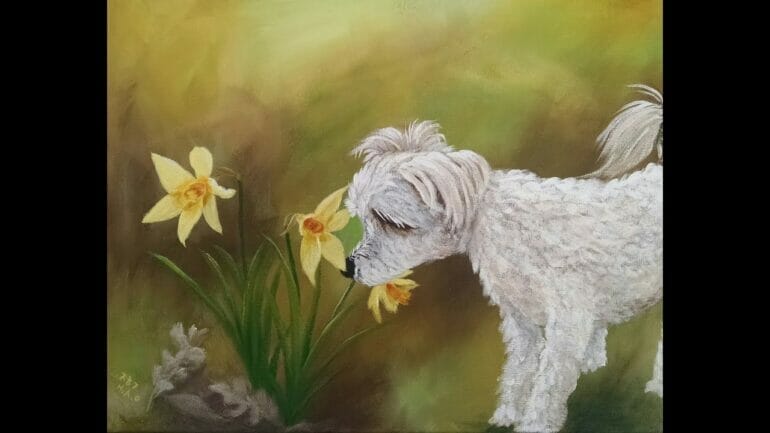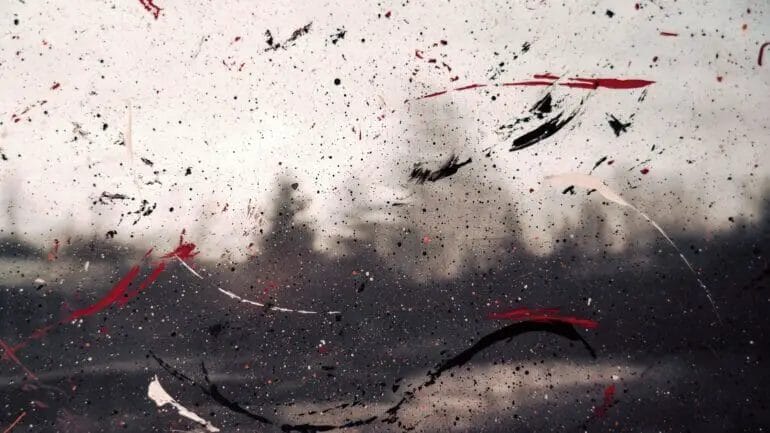If you want to learn how to paint a blurry background, you’ve come to the right place. Creating a blurred background can add depth and focus to your artwork, whether it’s a painting, drawing, or digital art. In this guide, we’ll walk you through the step-by-step process of achieving a beautifully blurred background that will make your subject stand out and create a sense of realism. So let’s dive in and unlock the secrets to creating stunning blurry backgrounds in your art!

Mastering the Art of Blurring: Techniques for Painting Blurry Backgrounds
Creating a sense of depth and focus in a painting is essential for capturing the viewer’s attention and guiding their gaze. One effective way to achieve this is by painting blurry backgrounds. Blurring the background can help bring the main subject into sharp focus and add a sense of realism to the artwork. In this section, we will explore some techniques that can help you master the art of painting blurry backgrounds.
1. Softening Edges
One of the simplest techniques for creating a blurry background is by softening the edges of objects in the background. This can be achieved by using a dry brush or a soft blending technique. Start by applying the base colors for the objects in the background, then use a soft brush to gently blend and blur the edges where they meet the main subject. This will create a gradual transition from sharpness to blurriness, giving the illusion of depth.
2. Atmospheric Perspective
Another effective technique for painting blurry backgrounds is using atmospheric perspective. This technique mimics how objects appear less distinct and blurrier as they recede into the distance due to atmospheric conditions. To achieve this effect, use lighter and less saturated colors for objects in the background. This will create the illusion of depth and distance, enhancing the blurry effect.
3. Depth of Field
Depth of field refers to the range of distance in a scene that appears acceptably sharp in an artwork. By controlling the depth of field, you can manipulate the level of blurriness in the background. To create a shallow depth of field and highlight the main subject, blur the background using a soft brush or a glazing technique. This technique works especially well for portrait or still life paintings, where the focus is on a specific subject.
4. Impressionistic Approach
If you want to create a more expressive and abstract feel in your artwork, you can adopt an impressionistic approach to painting blurry backgrounds. Instead of focusing on realistic details, use loose brushstrokes and vibrant colors to suggest shapes and forms in the background. This will create a sense of movement and energy while maintaining the blurriness.
5. Utilizing Layers
Layering is a technique commonly used in painting to build depth and texture. When painting blurry backgrounds, you can use multiple layers to gradually build up the level of blurriness. Start with a base layer of colors, then add subsequent layers with softer edges and lighter tones to create a sense of depth. This layering technique will enhance the blurry effect and give your artwork a more realistic appearance.
6. Experiment with Brush Techniques
Don’t be afraid to experiment with different brush techniques to achieve the desired blurry effect. You can try techniques such as stippling, scumbling, or dry brushing to create texture and blur in the background. Each brush technique will produce a unique effect, so it’s important to explore and find the one that works best for your artistic style and the desired outcome.
7. Practice and Observation
As with any artistic skill, mastering the art of painting blurry backgrounds requires practice and observation. Study photographs, observe the blurriness in the background, and try to replicate it in your artwork. Experiment with different techniques, colors, and brushstrokes to achieve the desired effect. With time and practice, you will develop your own style and techniques for creating stunning and realistic blurry backgrounds.
In summary, painting blurry backgrounds is a valuable technique for creating depth, focus, and realism in your artwork. By softening edges, utilizing atmospheric perspective, controlling the depth of field, adopting an impressionistic approach, utilizing layers, experimenting with brush techniques, and practicing regularly, you can master the art of painting blurry backgrounds and enhance the visual impact of your paintings.

Creating a Dreamy Atmosphere: Painting a Blurry Background in Art
When it comes to creating a captivating piece of artwork, the background plays a crucial role in setting the mood and tone. One technique that can help you achieve a dreamy and atmospheric effect is painting a blurry background. This technique not only adds depth to your artwork but also creates a sense of mystery and intrigue. In this section, we will explore the step-by-step process of painting a blurry background in art.
Materials Needed
Before we dive into the process, let’s gather the materials you’ll need:
- Canvas or painting surface
- Paintbrushes
- Acrylic or oil paints
- Palette
- Painting medium (optional)
- Solvent (if using oil paints)
- Water (if using acrylic paints)
- Soft cloth or paper towels
Step 1: Prepare Your Canvas
Start by preparing your canvas or painting surface. Make sure it is clean and free from any dirt or dust. If needed, you can apply a base coat of gesso to create a smooth surface for your painting.
Step 2: Choose Your Colors
Select the colors you want to use for your blurry background. Typically, muted and cool tones work best for creating a dreamy atmosphere. Consider shades of blues, purples, and greens. You can also add a touch of white or gray to soften the colors.
Step 3: Dilute Your Paint
To achieve a blurry effect, you’ll need to dilute your paint. If you’re using acrylics, add a small amount of water to your paint on your palette. For oil paints, use a painting medium or solvent to thin the paint. The key is to create a translucent consistency that allows the colors to blend easily.
Step 4: Apply the Base Layer
Start by applying a thin layer of your chosen colors to the entire background using a large brush. Work quickly and loosely, focusing on creating soft and smooth brushstrokes. Remember, the goal is to create a blurred effect, so don’t worry too much about details at this stage.
Step 5: Blend the Colors
Next, use a clean, dry brush or a soft cloth to blend the colors together. Gently stroke over the painted areas, using circular or sweeping motions. This will help soften the edges and create a seamless transition between the colors.
Step 6: Add More Layers
Once the first layer is dry, you can add additional layers to build up the blurry effect. Repeat the process of applying diluted paint and blending the colors. You can vary the intensity of the colors and create subtle variations to add interest and depth to the background.
Step 7: Fine-tune the Blurriness
If you want to enhance the blurry effect further, you can use a soft brush or a dry cloth to gently dab and smudge certain areas of the background. This will give the impression of distant objects or fog, adding to the dreamy atmosphere.
Step 8: Let it Dry
Allow your painting to dry completely before moving on to the next steps of your artwork. This will ensure that the colors and layers settle properly, giving you the desired blurry effect.
In summary, painting a blurry background in art is a technique that can help you create a dreamy and atmospheric effect. By carefully choosing your colors, diluting your paint, and blending the colors together, you can achieve a soft and blurred background that adds depth and intrigue to your artwork. So, grab your brushes and let your creativity flow as you paint your way to a dreamy masterpiece!

Enhancing Focus: How to Paint a Sharp Subject with a Blurry Background
Creating a sense of focus in a painting can greatly impact its overall visual impact. One effective technique is to paint a sharp subject with a blurry background. This technique not only draws attention to the main subject but also adds depth and dimension to the artwork. In this section, we will explore the step-by-step process of enhancing focus in a painting by creating a sharp subject with a blurry background.
1. Selecting the Subject
The first step in painting a sharp subject with a blurry background is to carefully choose your subject. Look for a subject that stands out from its surroundings and has defined edges. Flowers, portraits, or still-life objects are often popular choices for this technique.
2. Preparing the Canvas
Before starting the painting process, it is essential to prepare the canvas. Apply a thin layer of gesso to prime the surface and create a smooth base. Allow the gesso to dry completely before moving on to the next step.
3. Sketching the Subject
Once the canvas is ready, sketch the subject lightly using a pencil or charcoal. Pay close attention to the details and proportions of the subject to ensure accuracy in the final painting. You can use reference images or set up a still-life arrangement for this step.
4. Blocking in the Background
Next, start by blocking in the background using a large brush and muted colors. Keep the brushstrokes loose and slightly blurry to create the desired effect. Remember that the background should be less detailed and distinct compared to the main subject.
5. Adding Depth to the Background
To enhance the blurry effect, gradually add layers of paint to the background. Use a mix of colors and brushstrokes to create depth and dimension. Vary the opacity and translucency of the paint to achieve a realistic blurry background.
6. Refining the Sharp Subject
Once the background is complete, shift your attention to the main subject. Use smaller brushes and more precise strokes to paint the subject with sharp and crisp edges. Focus on capturing the details and textures of the subject to make it stand out.
7. Balancing the Contrast
As you paint the sharp subject, be mindful of the contrast between the subject and the background. Adjust the values and colors to ensure that the subject pops out from the blurry background. This contrast will further enhance the focus and visual impact of the painting.
8. Adding Final Details
Lastly, add the final touches and details to your painting. Pay attention to the highlights, shadows, and textures to bring the artwork to life. Use smaller brushes and precise strokes to refine the subject and create a sense of realism in the painting.
In summary, painting a sharp subject with a blurry background is an effective technique to enhance focus and create depth in your artwork. By carefully selecting the subject, blocking in the background, refining the subject, and balancing the contrast, you can achieve a visually striking painting. Remember to experiment with colors, brushstrokes, and layers to create a realistic and captivating effect. So, grab your brushes and start exploring the fascinating world of painting with enhanced focus.
Adding Visual Interest: Incorporating a Blurry Background in Your Paintings
When it comes to creating visually captivating paintings, artists are constantly exploring new techniques to add depth and interest to their artwork. One effective way to achieve this is by incorporating a blurry background. This technique not only enhances the focal point of the painting but also adds a sense of realism and depth to the overall composition.
Creating a blurry background requires a certain level of skill and understanding of composition. It involves strategically blurring certain areas of the background while keeping the main subject sharp and in focus. This contrast between the blurred background and the sharp focal point creates visual interest and draws the viewer’s attention to the main subject of the painting.
One of the key benefits of incorporating a blurry background is the ability to create a sense of depth in your artwork. By blurring the background, you can simulate the effect of depth of field, similar to what is achieved in photography. This technique adds layers to your painting, making it visually intriguing and engaging.
There are several ways to achieve a blurry background in your paintings. One common technique is using a soft brush or sponge to create a gentle, hazy effect. By lightly dabbing the brush or sponge on the canvas, you can create a soft, out-of-focus background. This technique works particularly well for landscape paintings, where you want to create a sense of distance and atmosphere.
Another approach is to use a dry brushing technique. With this method, you use a relatively dry brush and apply quick, light strokes to the background. This creates a textured, blurred effect that adds depth and interest to the painting. It is particularly effective for creating a sense of movement or energy in abstract or impressionistic artworks.
When incorporating a blurry background, it is important to consider the overall composition of your painting. The blurred areas should complement and enhance the main subject, rather than detract from it. Pay attention to the placement of the focal point and ensure that it remains the center of attention, even with the presence of a blurry background.
Color and value play a significant role in creating a successful blurry background. Experiment with different color schemes and observe how they interact with the main subject. Soft, muted colors tend to work well for creating a sense of distance and depth, while bold, vibrant colors can add drama and intensity to the overall composition.
Lastly, practice and experimentation are key when incorporating a blurry background in your paintings. It may take some time to master this technique and find the right balance between the sharp focal point and the blurred background. Don’t be afraid to try different approaches and techniques until you achieve the desired effect.
In summary, incorporating a blurry background in your paintings is a powerful technique to add visual interest and depth to your artwork. By strategically blurring certain areas of the background, you can create a sense of realism and draw the viewer’s attention to the main subject. Experiment with different techniques, colors, and compositions to find the perfect balance and enhance the overall impact of your paintings.
FAQs
1. How can I paint a blurry background?
To paint a blurry background, start by applying a base layer of the background color. Then, use a soft brush or sponge to add a lighter or darker shade of the background color in a hazy, out-of-focus manner. Avoid sharp edges and details to create a sense of depth and blur in the background.
2. What techniques can I use to achieve a blurry background in my painting?
There are several techniques you can use to achieve a blurry background in your painting. One popular technique is called “glazing,” where you apply thin layers of translucent paint over the background to create a soft, blurry effect. Another technique is to use a dry brush, lightly dabbing or dragging a dry brush over the background to create a blurred texture.
3. Are there any specific brushstrokes or tools that can help create a blurry background?
Yes, there are specific brushstrokes and tools that can help create a blurry background. For example, using a fan brush or a soft, large brush can help you achieve a softer, blended look. Additionally, using a technique called “scumbling,” where you lightly and quickly brush or dab paint over the background, can also create a blurry effect.
Conclusion
In conclusion, painting a blurry background can add depth and dimension to a artwork. It is a technique that requires a combination of observation, patience, and skill. By using soft brush strokes, muted colors, and blending techniques, artists can create a sense of distance and atmosphere in their paintings. Remember to consider the focal point of your artwork and use the blurry background as a supporting element to enhance the overall composition. Whether you’re a beginner or an experienced artist, experimenting with different techniques and styles will help you develop your own unique approach to painting blurry backgrounds. So grab your brushes and start exploring the artistry of creating stunning and captivating backgrounds.
